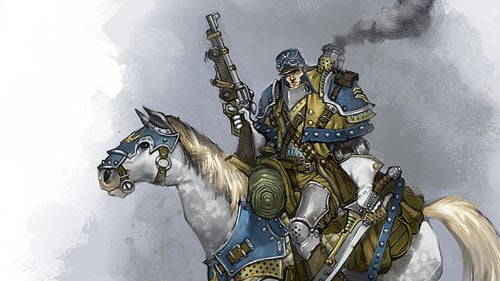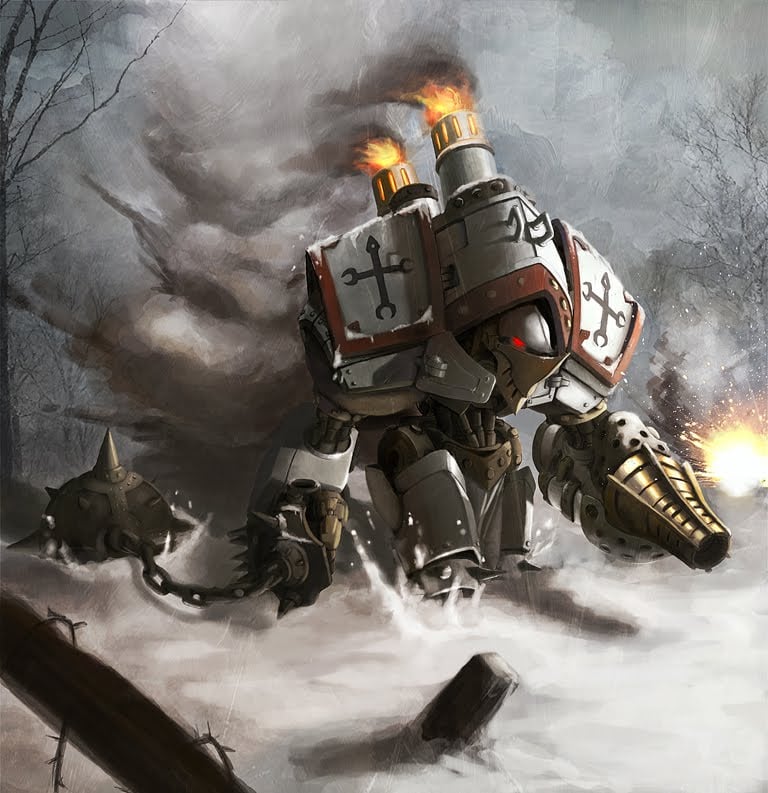Warmachine: Fun is Subjective

Believe it or not, Warmachine is one of the most refined table-top games that I’ve played in a long time. By refined, I’m referring to how the rules translate to fun on the table. The cover system, the combat system, the synergetic activation of units, and the fact that the game changes completely depending on what warcaster you have are all key points in making the game exciting. In this article, I will expand on the things that make Warmachine my favorite table-top game right now.
I’ll start off by comparing the combat system with that of 40K. In short, 40K is about rolling a bunch of dice for the sake of wound saturation. If you’re Marines (or MEQ) you need 3s, if you’re Guard you roll 4s and that’s pretty much the end of it. In close combat, it’s pretty much the same system. Get into rapid fire bolter range and throw a bunch of dice, or get into melee with a bunch of Orks and do the same. There’s no flexibility to what you want to do with your attacks. You just throw dice and pray to the dice gods that things go your way. Warmachine is different. It expands on a combat system that lets you dictate the amount of damage you want to inflict. You can spend focus to increase your accuracy in range or in combat and you can spend focus to boost your damage rolls.
For those who are unfamiliar with the combat system of Warmachine, you roll 2d6 + your RAT/MAT (ranged or melee attack value) and compare it to your targets’ defense value. If you hit, you roll a 2d6 + the strength of your attack (P+S or POW) and compare it to your target’s armor value (ARM). The difference (if greater) is the damage. Since there’s less attacks in Warmachine because there’s a finite amount of focus/fury and most infantry models only get one attack, you have more control of what happens. After 10 years of throwing tons of dice for bolter shots and close combat attacks, this is a welcome change.
In terms of cover, Warmachine has what I want in a minis game. The best part about the cover system of Warmachine is that it makes sense aesthetically. I can’t have 13 models out of 25 behind cover and the entire unit gets a 4+ cover save like in 40K. An extreme example, I agree, but things like this does happen and the power gamers out there will make sure it happens in game. I don’t know about you folks, but it’s that kind of stuff that really takes away the “feel” of the game. When things don’t look visually logical, that’s when my immersion fades and I’m no longer into the game. It’s quite depressing.
In WM, the concealment/cover bonuses offered only applies to the model that’s taking cover. If you have a model that’s taking cover behind some light cover, you’ll receive +2 to your model’s defense. Hard cover (or just cover in WM) gives you +4. Unlike 40K’s rigid cover system where your opponent makes a 4+ cover save and that’s it, the integration with the cover system with the flexible combat system is what makes Warmachine really interesting. I know I can’t depend on cover to protect my units from a smart opponent that knows how to spend his focus, but it does offer me some protection. This is exactly what I want in a minis game: more fighting, more killing and less hassle about whether or not I get that desperate 4+ cover.
Another thing I like about Warmachine is how the units interact in battle. Being a smaller, skirmish-style game; the units in Warmachine activates in the order that you want. The order of operations in battle is extremely crucial in how certain combos play out. Here’s a brief example:
- I allocate Focus to my Ironclad.
- I activate my Warcaster and he casts spells that gives my Ironclad extra movement.
- My Ironclad charges and I boost to hit to slam the opposing warcaster on the ground.
- Arlan moves and Power Boosts my Defender.
- My Defender aims and hits the now vulnerable warcaster and boosts his damage roll for the game.
Look at how many units worked with each other to deliver the final result. Every unit actively participated and I think this type of synergetic gameplay is missing in something like 40K. In terms of army list synergy, I would say that Warmachine is more like Fantasy. If I played a magic heavy army for example (in WHFB), I would make sure certain spells get off when I know combat needs to swing my way. The same would apply in the movement phase where I would setup charges and flanks. In 40K, I move units forward, I hug cover as much as I can, I shoot a bunch by rolling a ton of dice, and I do the same in the assault phase (if at all). I don’t even need to describe what happens in a battle report because it pretty much speaks for itself.
When building a list for 40K, I throw in a bunch of effective units and that’s the end of it. Sure, I can say that I need more anti-tank or more anti-infantry and compensate for that, but the actual list itself is pretty self-explanatory. In Warmachine, each and every unit has to play their part in order for you to secure victory. This depends specifically on which hero you take to battle – which Warcaster will lead your army. He is the one that dictates your playstyle and what units you need to bring to be effective. The best thing about Warmachine is that every warcaster plays so radically different that every army list will be different. For my Space Wolves, I just take a bunch of Grey Hunters in Rhinos and fill in the rest with a flip of a coin. Yes, yes, I know.. another extreme example, but that’s just how I feel. Even though there are those awesome and “must have” units in WM as well (such as Great Bears, B13th or an Avatar of Menoth), those units are never mandatory to win your games. That, I assure you.
Lastly, I want to touch upon the vaulted Pg.5 of the main Warmachine rulebook. For those that don’t know, it’s basically the design philosophy of Warmachine and what’s to be expected before you play. It flat out says that the game is meant to be aggressive, it’s non-forgiving and it’s not for the feint of heart. The design of the game is made so that you have to get up close and personal with your opponent and do game-winning damage. Now I don’t know how many of you have sat across from a Empire gunline or a Space Wolf Razorback list, but those type of games just doesn’t do it for me anymore. I want to be able to get in there and have fun and I think that that type of encouragement is exactly what this genre needs. Whether or not guneline-style armies are effective in Warmachine is another story — just know that I haven’t had any luck with it and I play Cygnar. You absolutely need the hack and slash of bloody melee in there and I love it.
Well, that’s it. I don’t know what else to tell you guys except that the game is awesome. It might look simple at first since there’s a lot less models on the field, but each of these models do different things and have their own role in the army. Every unit adds a bit of synergy to the warcaster’s ultimate gameplan and each game will be distinctly different than the next. I’ve been Warmachine for less than a year and I’m still learning new things every time I play. Come check our my blog and read a few of my army lists and battle reports so you can get a better feel of the game. Trust me though.. if there’s only one game I can recommend per year, this would be that one.
Have at it folks, all comments are welcome!








